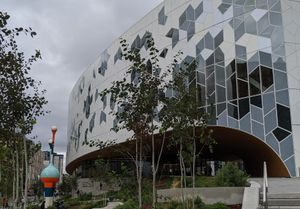I have found that the phrase Discovery happens elsewhere has quite a bit of resonance in discussion.
Increasingly people discover websites, or encounter content from them, in a variety of places. Most clearly, this happens through network-level services like Google or Twitter, but also happens in personal services (my RSS aggregator), or services which allow me to traverse from personal to network (social networking, bookmarking, …). The library may also want to ‘place’ resources in various ways in other environments, course management systems for example.
If discovery happens elsewhere, then there are several important consequences for libraries. Most important is the recognition that a library’s own, locally managed or provided discovery environments – the catalog, metasearch service or discovery layer – are only a part of the picture, that there are other areas of discovery which would benefit from attention.
Libraries will also want to support indirect discovery. By this I mean, they will want to connect the discovery experience, whenever it happens outside of the library environment, to the possibility of fulfillment in the library.
This may happen in several ways. Importantly, it makes sense that libraries will want to disclose the existence of their resources into other discovery environments. Think of a library’s unique resources for example, its digitized special collections, for example, or the institutional assets it manages in an institutional repository. As with other information providers on the web, the library will want to make sure that these are exposed in ways that optimize crawling, indexing and finding by search engines. Other approaches may be sensible, adding relevant links to Wikipedia pages for example, or selectively putting images from the collection on Flickr.
For non-unique resources a library may want to disclose the fact that it holds a particular item. Think here, for example, of making sure that Google Scholar knows how to resolve article metadata to your particular library (see the Library Links program). Or of being represented in one of the several union catalogs (including Worldcat) that Google uses to direct the ‘find in a library’ link on Google Book Search.
Another approach is to ‘leverage’ a discovery environment which is outside of your control to bring people back to your environment. Here I am thinking of the use of tools like LibX, which may mobilize metadata found ‘elsewhere’ in a variety of ways to connect to a particular library resource. The developers report that LibX has been customised for over 700 different use environments.
Other approaches could also be discussed. We don’t yet have a routine way of supporting ‘indirect discovery’ or a shared inventory of use cases. This will be one of the more interesting development areas in coming years.
Related resources:
Lorcan Dempsey. The library catalogue in the new discovery environment. Ariadne Issue 48 June 2006.
https://www.ariadne.ac.uk/issue48/dempsey/
Lorcan Dempsey. Discovery and delivery. Presentation and webcast presentation from University of Minnesota speaker series.
Share
More from LorcanDempsey.net



